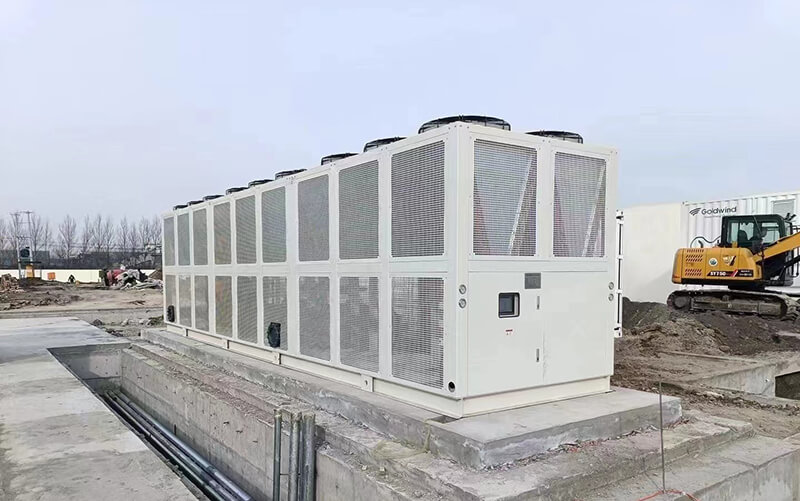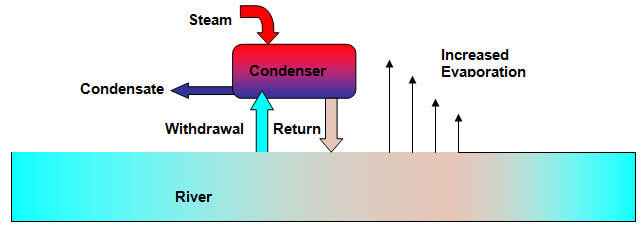In the realm of industrial and commercial chiller, not all chiller systems are created equal, and the choice between a closed-loop and an open-loop chiller system can significantly impact operational efficiency, cost-effectiveness, and environmental sustainability.
Closed-loop chillers, with their recirculating cooling mechanisms, offer a distinct set of advantages and considerations compared to their open-loop counterparts, which interact more directly with the environment. This blog post aims to shed light on these two systems, offering a comparative analysis of closed-loop versus open-loop chiller systems.

What is Closed-Loop Chiller System
Closed-loop chiller systems operate on a principle of recirculation, employing a coolant that circulates within a sealed circuit, effectively eliminating direct exposure to the external environment. This design not only enhances the system’s efficiency but also significantly reduces the risk of contamination and evaporation.

Closed-Loop Chiller System Components
- Coolant Reservoir: Holds the coolant, which is recirculated within the system.
- Pump: Circulates the coolant through the system.
- Evaporator: Where the coolant absorbs heat from the process or space being cooled, causing the coolant to vaporize while removing heat from the system.
- Compressor: Increases the pressure of the vaporized coolant, preparing it for condensation.
- Condenser: Cools the vaporized coolant back into a liquid form, releasing the absorbed heat to the environment or a secondary coolant system.
- Expansion Valve: Reduces the pressure of the coolant before it returns to the evaporator, completing the cycle.
- Thermal Controller: Monitors and regulates the temperature of the coolant within the system, adjusting the cooling effect as needed.
How Closed-Loop Chiller Systems Work
At the core of a closed-loop chiller system is the coolant’s journey, initiated in a cooling tank where it is chilled to the desired temperature. This coolant then traverses through the system, absorbing heat from the process or equipment it is tasked to cool. Post heat absorption, the now-warm coolant returns to the chiller where it relinquishes its thermal load before being re-cooled and sent back into circulation. This continuous cycle allows for efficient heat exchange without the loss of coolant volume or quality.
Advantages of Closed-Loop Systems
Closed-loop chiller systems offer a multitude of benefits that cater to the demanding needs of modern industrial operations:
- Reduced Water and Coolant Usage: By recirculating the coolant, these systems drastically lower the need for constant replenishment, leading to significant resource and cost savings.
- Less Space Requirement: The compact design of closed-loop systems eliminates the need for extensive infrastructure like cooling towers, making them ideal for facilities with limited space.
- Lower Energy Consumption: Efficient coolant recirculation and advanced temperature control mechanisms allow these chillers to operate with minimal energy waste, translating into lower utility bills.
- Precise Temperature Maintenance: The closed circuit provides a controlled environment for exact temperature regulation, ensuring optimal conditions for sensitive processes and equipment.
- Savings on Operational and Waste Costs: The efficiency and effectiveness of closed-loop systems result in lower operational expenses and reduced waste disposal issues, aligning with environmental regulations and sustainability goals.
- Lower Maintenance Requirements: The sealed nature of the system protects it from external contaminants, reducing the frequency and complexity of maintenance tasks.
Disadvantages of Closed-Loop Systems
Despite their numerous advantages, closed-loop chillers are not without challenges:
- Potential for Corrosion and Deposit Buildup: The closed nature of the system can lead to the accumulation of minerals or organic deposits, necessitating regular monitoring and maintenance to prevent efficiency losses.
- Need for Preventative Maintenance: To ensure long-term reliability and performance, these systems require a proactive maintenance approach, including the use of appropriate water treatment and anti-corrosion strategies.
What is Open-Loop Chiller System
In contrast to the closed-loop systems, open-loop chiller systems offer a different approach to industrial and commercial cooling, characterized by their direct interaction with the external environment. This type of chiller system facilitates the heat exchange process through direct air-to-water contact, making it a simpler yet effective means of cooling for a variety of applications.

Open-Loop Chiller System Components
- Water Intake: Brings fresh water or coolant into the system from an external source.
- Pump: Circulates the water or coolant through the system and out to the cooling tower or discharge point.
- Evaporator: Functions similarly to that in a closed-loop system, where the coolant absorbs heat from the process.
- Compressor: Increases the pressure of the vaporized coolant for condensation.
- Condenser: Releases the absorbed heat to the atmosphere directly or to a secondary coolant system, depending on the design.
- Cooling Tower (in some open-loop systems): Facilitates the release of heat from the water or coolant to the atmosphere before it is discharged or recirculated.
- Discharge Outlet: Allows for the expulsion of used water or coolant from the system into a drainage system or back into the environment.
How Open-Loop Chiller Systems Work
Open-loop chillers function by pumping water or another coolant directly from an external source, such as a pond, river, or city water supply, through the chiller unit where it absorbs heat from the industrial process. After collecting the heat, the warmed water is discharged back into the external source or into a separate drainage system. This direct contact between the coolant and the air plays a crucial role in the cooling process, enabling efficient heat dissipation but also exposing the system to potential environmental contaminants.
Advantages of Open-Loop Systems
- Simplicity and Ease of Use: Open-loop systems are straightforward in design and operation, making them accessible for a wide range of applications without the need for complex infrastructure.
- Potentially Lower Initial Setup Costs: The relative simplicity of open-loop systems often translates into lower initial investment costs, as they require fewer components and less intricate plumbing than their closed-loop counterparts.
Disadvantages of Open-Loop Systems
However, the openness of these systems introduces several challenges that can impact their efficiency and environmental footprint:
- Higher Water and Coolant Consumption: Since the coolant is not recirculated but instead discharged after use, open-loop systems can consume significantly more water. This not only increases operational costs but also raises sustainability concerns.
- Increased Risk of Contamination: Direct exposure to environmental air means that open-loop chillers are more susceptible to contamination by airborne particles, biological growth, and chemicals, which can reduce efficiency and increase maintenance needs.
- Greater Space Requirements: Unlike closed-loop systems, open-loop chillers may require access to large volumes of water and potentially cooling towers, increasing the spatial footprint needed for installation.
- Higher Operational Costs Due to Waste Disposal and Environmental Impact: The continuous intake and discharge of water necessitate rigorous treatment to meet environmental discharge standards, leading to higher operational and waste disposal costs.
| Feature | Closed-Loop Chiller System | Open-Loop Chiller System |
|---|---|---|
| Water and Coolant Usage | Reduced usage due to recirculation | Higher consumption as water is used once then expelled |
| Space Requirements | Less space required due to lack of external cooling towers | Greater space needed for cooling towers and additional equipment |
| Energy Consumption | Lower energy consumption through efficient recirculation and cooling | Higher energy consumption due to continuous cooling and pumping of new water |
| Precision in Temperature Maintenance | Highly precise temperature control thanks to recirculated, conditioned coolant | Less precise, subject to variations in water supply and environmental conditions |
| Operational and Waste Costs | Lower costs due to reduced coolant needs and minimal waste | Higher costs related to water treatment, disposal, and continuous coolant replenishment |
| Maintenance Requirements | Lower maintenance, though regular checks for corrosion or buildup are necessary | Higher maintenance due to potential contamination and system scaling |
| Environmental Impact | Reduced impact through coolant recycling and less waste production | Higher potential impact due to waste water disposal and chemical treatments |
| System Complexity | More complex due to closed circuit and cooling mechanism | Simpler system with direct cooling, easier to understand and implement |
| Initial Setup Costs | Potentially higher due to the complexity and components involved | Lower initial costs, simpler setup and infrastructure |
Conclusion
In our comparison between closed-loop and open-loop chiller systems, we’ve seen how each system uses water and energy, the amount of space they need, their impact on our environment, and the costs involved in keeping them running. Closed-loop systems are great for saving water and energy, work well in smaller spaces, and are kinder to the environment. However, they might need a bit more attention to avoid internal issues like rust. On the other hand, open-loop systems might be easier to set up and use but can end up using more resources and might not be as good for the planet.
Choosing the right chiller system depends on what’s most important for your situation. Do you need to save space? Is saving on water and energy bills a priority? How much maintenance can you handle? And, of course, how much are you willing to spend not just upfront but over time? These are all crucial questions that can help guide your decision.
SCY Chiller Offers the Closed-Loop Chiller You Need
Are you ready to make your cooling system more efficient, environmentally friendly, and cost-effective? Don’t go it alone. Contact us today to learn more about your options and find the chiller system that’s just right for you. Whether you’re looking to install a new system or upgrade your current one, expert advice can make all the difference. Reach out now and take the first step towards a cooler, more sustainable future for your business.

Bjr…Merci pour toute ses informations sur le froid industriel.
You are welcome, Varlet